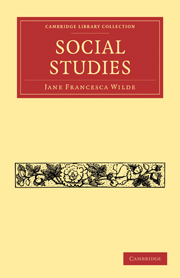Book contents
- Frontmatter
- Contents
- WORKS BY LADY WILDE
- THE BONDAGE OF WOMAN
- GENIUS AND MARRIAGE
- SOCIAL GRACES
- VENUS VICTRIX
- SPIRITUAL AFFINITY
- SUITABILITY OF DRESS
- AMERICAN WOMEN
- THE WORLD'S NEW PHASES
- THE DESTINY OF HUMANITY
- AUSTRALIA (a Plea for Emigration)
- THE VISION OF THE VATICAN
- IRISH LEADERS AND MARTYRS
- THE POET AS TEACHER
- THE TWO ARTISTS: A SKETCH (from the Spanish)
- ‘TERTIA MORS EST’ (from the German,)
- Frontmatter
- Contents
- WORKS BY LADY WILDE
- THE BONDAGE OF WOMAN
- GENIUS AND MARRIAGE
- SOCIAL GRACES
- VENUS VICTRIX
- SPIRITUAL AFFINITY
- SUITABILITY OF DRESS
- AMERICAN WOMEN
- THE WORLD'S NEW PHASES
- THE DESTINY OF HUMANITY
- AUSTRALIA (a Plea for Emigration)
- THE VISION OF THE VATICAN
- IRISH LEADERS AND MARTYRS
- THE POET AS TEACHER
- THE TWO ARTISTS: A SKETCH (from the Spanish)
- ‘TERTIA MORS EST’ (from the German,)
Summary
Woman lies at the base of all life, whether for good or evil. From Eden to Olympus, woman is the first word written on the page of every history and of every religion, and is the illuminated initial of every man's life. The true Venus Victrix of creation, her influence is infinite and illimitable, and the world has bowed, and will for ever bow, before the sceptre of womanhood. Through her beauty she reigns a queen, and through her sympathy she is the mediating priestess of human destiny; and her power over man, whether through beauty or love, through purity or sin, is the crown or the torture, the glory or the perdition, of almost every human career.
‘Beware of women!’ exclaims a brilliant French writer; ‘if they do not crown you, they will strangle you.’ Yet reason can do little against the force of beauty; the first impulse, the irresistible instinct of a man's nature is the homage to physical beauty. It has a mystic power that sweeps down all before it, the strongest and wisest. A French writer says, with the eloquent extravagance of his nation and idiom, ‘What can equal a woman's beauty?
- Type
- Chapter
- Information
- Social Studies , pp. 78 - 96Publisher: Cambridge University PressPrint publication year: 2010First published in: 1893

